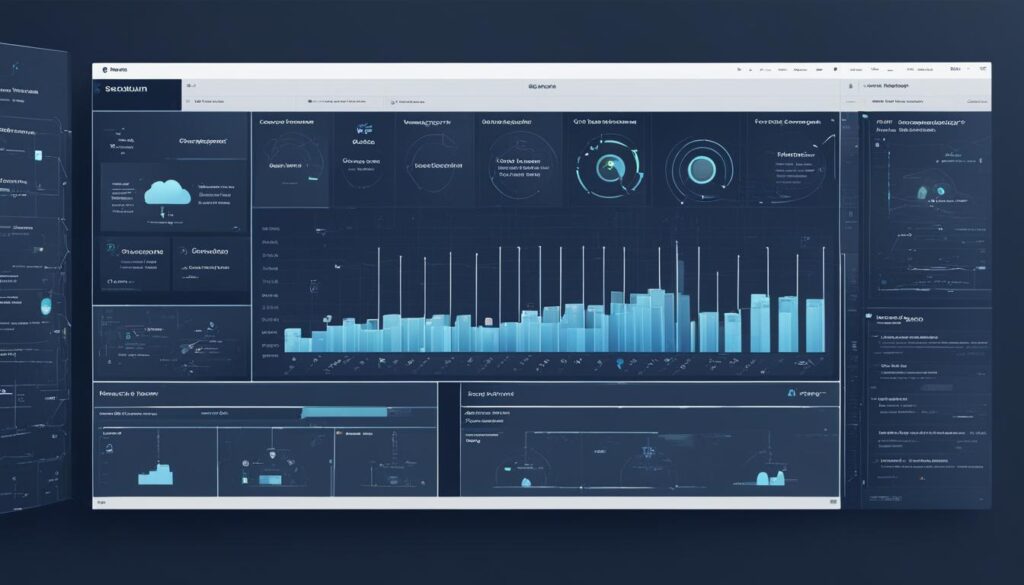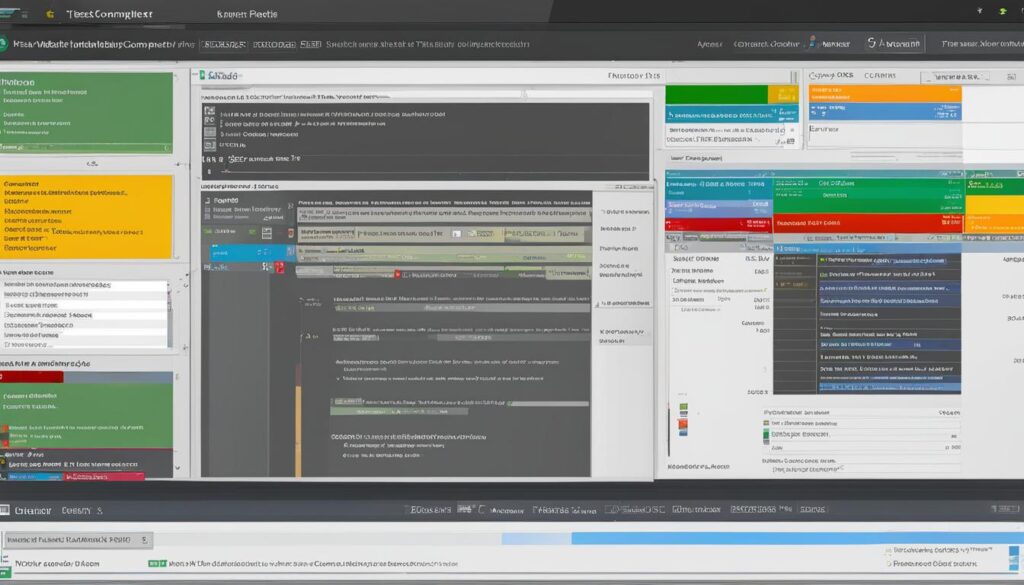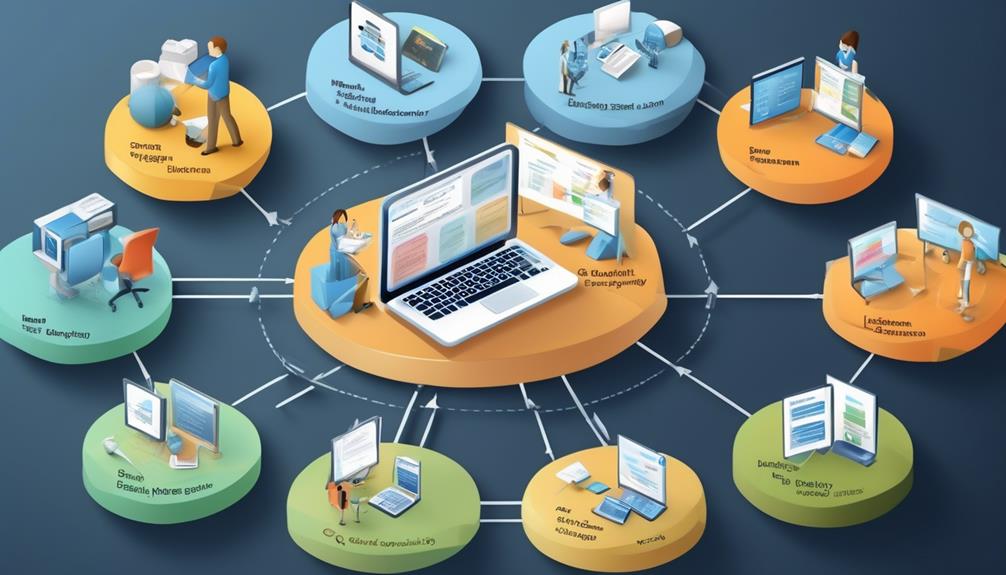SQA Techniques and Tools
Best SQA Automation Tools for Efficient Testing

Ensuring software quality is crucial in the development process, and automation is essential for meeting high standards. At [Your Company Name], we recognize the significance of efficient testing practices and are dedicated to utilizing the top SQA automation tools on the market.
In this article, we will explore a comprehensive list of SQA automation tools that streamline the testing process, enhance productivity, and deliver reliable results. Whether you are a beginner or an experienced QA professional, these tools have the features and capabilities to meet your specific testing needs.
Key Takeaways:
- SQA automation tools are essential for efficient software testing and quality assurance.
- Choosing the right automation tool depends on your specific needs and requirements.
- The top SQA automation frameworks include Selenium, Scandium, Appium, TestComplete, and Katalon Studio.
- These tools offer a range of features, support for different programming languages, and user-friendly interfaces.
- Effective automation tools contribute to industry-leading software quality and user satisfaction.
Selenium – A Popular Open-Source Test Automation Framework
Selenium is a widely used open-source test automation framework known for its robust features and extensive community support. It offers tools and libraries for automating web applications and supports multiple programming languages such as Java, Python, and C#. Selenium is a popular choice for beginners due to its vast online resources and community support, making it easier to find help and resources.
Key Features of Selenium:
- Open-source test automation framework
- Designed for automating web applications
- Supports multiple programming languages
- Extensive community support and online resources

The Benefits of Scandium
Scandium brings numerous benefits to the table:
- No-code test automation: No programming skills required, making it accessible to beginners.
- Time savings: Record-and-playback feature accelerates test creation and execution.
- Easy test maintenance: Modify and update tests effortlessly with Scandium’s intuitive interface.
- Efficient test case management: Organize and execute tests with ease using Scandium’s robust features.
With its no-code approach, intuitive interface, and powerful features, Scandium is transforming the way we approach test automation. Whether you’re just starting or have years of experience, Scandium is a valuable addition to any QA professional’s toolkit.
Appium – A Fantastic Choice for Mobile App Testing
When it comes to mobile app testing, Appium stands out as a fantastic choice. As an open-source tool, it offers a range of features that make testing native, hybrid, and mobile web applications a breeze on both Android and iOS platforms. With its cross-platform capabilities and support for multiple programming languages, Appium is an excellent option for beginners and experienced testers alike.
One of the key advantages of using Appium is its open-source nature. This means that developers and testers can access and modify its source code, making it highly customizable to meet specific testing needs. Appium’s open-source community is also active and supportive, providing valuable resources, documentation, and updates.
Native, Hybrid, and Mobile Web Applications
Appium allows for seamless automation of native, hybrid, and mobile web applications. This versatility makes it incredibly convenient for testing various types of mobile apps, ensuring consistent performance and functionality across different platforms.
Whether you’re developing a native app specifically for Android or iOS or working on a hybrid app that combines web and native elements, Appium has you covered. It offers the necessary tools and features to automate your tests, providing accurate results and valuable insights.
Cross-Platform Capabilities
Appium’s cross-platform capabilities are invaluable for teams working on applications that need to run smoothly on both Android and iOS platforms. Instead of developing separate test scripts for each platform, Appium allows you to write tests once and execute them on multiple platforms, saving time and effort.
This cross-platform compatibility also extends to the programming languages supported by Appium, such as Java, Python, Ruby, and C#. This flexibility enables testers to write tests in their preferred language, leveraging their existing skills and knowledge.
Furthermore, Appium’s compatibility with popular integrated development environments (IDEs) like Eclipse, IntelliJ IDEA, and Visual Studio ensures a seamless integration within your existing development workflow.

Appium’s ability to test mobile apps across different platforms and its support for multiple programming languages make it a powerful tool in the hands of testers. Whether you’re a beginner or an experienced QA professional, Appium simplifies the mobile app testing process and helps identify and fix issues before your app reaches the hands of users.
Appium’s flexibility, cross-platform capabilities, and community support have made it a popular choice among mobile app testers. Its open-source nature, combined with its ability to automate native, hybrid, and mobile web applications, ensures comprehensive coverage and reliable results.
TestComplete – User-Friendly Test Automation Tool for Web and Desktop Applications
When it comes to test automation for both web and desktop applications, TestComplete is a top choice. This user-friendly tool offers a range of features that make it easy for beginners and experienced testers alike to create and execute test scripts.
One of the standout features of TestComplete is its record-and-playback capability. This convenient feature allows users to record their interactions with the application and generate test scripts automatically, without the need for extensive coding knowledge. This makes it an ideal choice for testers who may not have programming expertise.
Furthermore, TestComplete provides a wide range of built-in test objects, meaning users have access to a comprehensive library of UI elements and controls specific to web and desktop applications. This built-in functionality enhances ease of use and test creation, as it eliminates the need to manually identify and configure individual UI elements.
With TestComplete, creating and executing tests becomes a streamlined process, allowing testers to focus on ensuring the quality and functionality of web and desktop applications.
| Key Features | Benefits |
|---|---|
| Record-and-playback feature | Efficient test script creation without coding |
| Built-in test objects | Simplified test creation and management |
| Support for web and desktop applications | Versatility to test various types of applications |

TestComplete offers a reliable and intuitive user interface, ensuring that both beginners and experienced testers can navigate the tool effectively. With its extensive capabilities, TestComplete is a valuable asset in any testing arsenal, enabling efficient and thorough testing of web and desktop applications.
Katalon Studio – Comprehensive Automation Tool for Beginners and Experienced Testers
When it comes to automation testing, Katalon Studio stands out as a comprehensive tool suitable for both beginners and experienced testers. Its user-friendly interface, coupled with powerful features, makes it an ideal choice for streamlining testing efforts and achieving efficient results.
One of the standout features of Katalon Studio is its simple and intuitive interface. Testers can quickly familiarize themselves with the tool, allowing for a smooth onboarding process. Whether you’re a beginner or an experienced tester, Katalon Studio’s user-friendly interface ensures that you can easily navigate through the tool and create automated tests without hassle.
Another notable aspect of Katalon Studio is its built-in test frameworks, which provide a solid foundation for test creation. With these frameworks, testers can leverage predefined functions and modules to expedite the test development process. This feature is particularly beneficial for beginners who may not have extensive coding knowledge, allowing them to create robust and reliable tests with ease.
“Katalon Studio’s built-in test frameworks have truly revolutionized the way we approach automation testing. They have drastically reduced our development time and made it possible for our team to focus more on test design rather than writing complex scripts.”
In addition to its user-friendly interface and built-in frameworks, Katalon Studio also offers a scripting option for advanced users. This feature enables experienced testers to further customize their tests by adding complex logic and extensions. With the scripting option, Katalon Studio caters to the diverse needs of automation testers, empowering them to create highly specialized and tailored tests.
Overall, Katalon Studio’s comprehensive set of features, including its simple user-friendly interface, built-in test frameworks, and scripting option, make it an excellent choice for both beginners and experienced testers. Whether you’re just starting your automation journey or looking to enhance your existing testing workflows, Katalon Studio provides the tools you need to achieve efficient and reliable test automation results.
Key Features of Katalon Studio
| Feature | Description |
|---|---|
| Simple and User-Friendly Interface | Katalon Studio offers an intuitive interface that promotes easy navigation and quick adoption. |
| Built-in Test Frameworks | The tool provides prebuilt test frameworks that accelerate test development for efficient automation. |
| Scripting Option | Advanced users can leverage scripting capabilities to customize tests and add complex logic. |

With Katalon Studio, automation testing becomes accessible and efficient, allowing testers to achieve comprehensive test coverage and ensure the quality of their software. Whether you’re a beginner taking the first steps in automation or an experienced tester seeking a versatile tool, Katalon Studio is a reliable choice that empowers you to deliver high-quality software products.
Key Features and Concepts of Scandium
Scandium, our no-code automation tool, offers an array of powerful features designed to enhance your testing experience. With Scandium, you can create and execute tests without writing a single line of code. Let’s explore the key features that make Scandium a valuable addition to your testing toolkit:
No-Code Automation
Scandium’s intuitive interface allows anyone, regardless of their programming background, to design and execute automated tests effortlessly. The record-and-playback feature simplifies the test creation process, empowering testers to focus on identifying critical scenarios and validating software functionality.
Efficient Test Case Management
Organizing test cases is crucial for effective test management. Scandium offers organizational folders that enable you to categorize and manage your test cases efficiently. This feature simplifies navigation and ensures that your test cases remain structured, making it easier to maintain and reuse them in future testing cycles.
Detailed Reporting and Analytics
Scandium provides detailed reporting and analytics capabilities, allowing you to track the progress and results of your test executions. This feature enables you to generate valuable insights and identify patterns and trends in your testing efforts. Clear and comprehensive reports help you communicate the status and quality of your software to stakeholders effectively.
Streamlined Test Case Creation
Creating test cases in Scandium is a breeze. With its user-friendly interface, you can define test steps and events in a logical and structured manner. This feature promotes test case reusability, ensures accurate test coverage, and speeds up the test creation process.
Test Execution and Validation
Scandium simplifies the process of executing and validating your automated tests. With just a few clicks, you can initiate test execution and monitor the progress in real-time. Scandium provides clear and detailed logs, making it easier to identify any issues and validate the functionality of your software.
Scandium’s no-code automation, efficient test case management, detailed reporting, streamlined test case creation, and seamless test execution and validation processes allow you to focus on delivering high-quality software without the burden of extensive coding. It’s the perfect tool to enhance your testing efficiency and achieve your quality assurance goals.
| Feature | Description |
|---|---|
| No-Code Automation | Design and execute automated tests without coding |
| Efficient Test Case Management | Organize test cases effortlessly with organizational folders |
| Detailed Reporting and Analytics | Generate valuable insights with comprehensive reports |
| Streamlined Test Case Creation | Create test cases quickly and accurately |
| Test Execution and Validation | Execute and validate tests with ease |
Choosing the Right Automation Testing Tool
When it comes to automation testing tools, selecting the right one is essential for a successful testing strategy. With the rapid growth of Agile and DevOps practices, teams need tools that align with their specific needs and can seamlessly integrate into their workflows. To make a well-informed decision, teams must consider various factors such as evaluation strategy, features, integrations, maintenance ease, budget, and technical support.
First and foremost, it is crucial to evaluate the specific needs of your team. Identify the requirements and challenges you face in your testing process. Determine whether you need a tool that supports web or mobile app testing, or both. Consider the programming languages that your team works with and ensure the tool has support for those languages.
Additionally, evaluating the scalability of the tool is essential. As your organization grows and your testing needs evolve, you will want a tool that can scale to meet those demands. Look for automation testing tools that offer scalability options, such as the ability to run tests across multiple environments and handle large test suites efficiently.
Integration capabilities with other tools in your development ecosystem are vital for seamless collaboration and efficient workflow. Identify the tools your team currently uses, such as issue trackers, CI/CD platforms, and version control systems, and ensure the automation testing tool can integrate with them. This will help create a connected and streamlined development environment.
Quote: “Choosing the right automation testing tool requires careful consideration of factors such as specific needs, team resources, future scalability, integrations, maintenance ease, budget, and technical support.”
Another crucial aspect to consider is the ease of maintaining test scripts. Test scripts need regular updates and maintenance to ensure they remain accurate and reliable. Look for tools that provide a user-friendly interface and intuitive scripting capabilities, allowing testers to easily maintain and update test scripts without extensive coding knowledge.
However, one cannot overlook the importance of budget constraints. Evaluate your team’s budget and compare it with the cost of the automation testing tools you are considering. It’s essential to strike a balance between the features and capabilities of the tool and your team’s financial resources.
Lastly, technical support is crucial for successfully implementing and maintaining an automation testing tool. Look for vendors that offer comprehensive technical support, including documentation, online resources, and responsive customer support. This ensures that you have access to assistance when facing any challenges or questions during the implementation and usage of the tool.
Sample Evaluation Matrix:
| Factor | Tool A | Tool B | Tool C |
|---|---|---|---|
| Specific Needs | ✓ | ✓ | ✓ |
| Scalability | ✓ | ✓ | ✓ |
| Integrations | ✓ | – | ✓ |
| Maintenance Ease | ✓ | – | ✓ |
| Cost | $$$ | $$ | $$ |
| Technical Support | ✓ | ✓ | ✓ |
Using an evaluation strategy similar to the table above can help you compare different automation testing tools and make an informed decision based on your team’s specific requirements.
Ultimately, choosing the right automation testing tool involves a thorough evaluation of your team’s needs, features offered, integration possibilities, ease of maintenance, budget constraints, and technical support. By carefully considering these factors, you can find the tool that best aligns with your team’s goals and significantly improves your software testing process.
Conclusion
In conclusion, selecting the right SQA Automation Tools is crucial for efficient software testing and ensuring high software quality. The top SQA automation frameworks, including Selenium, Scandium, Appium, TestComplete, and Katalon Studio, offer a wide range of features and cater to different skill levels. These tools streamline the testing process, allowing for efficient and effective testing of software applications.
By using these best automation tools for software testing, QA professionals can generate valuable feedback that leads to software quality improvements. The automation capabilities provided by these tools help identify bugs and issues early on, facilitating prompt resolution and reducing the likelihood of software defects reaching end-users. This results in higher user satisfaction and enhances the overall quality of software products.
With their extensive features, these SQA automation tools enable testers to write maintainable, reusable scripts, execute tests efficiently, and generate detailed reports. The efficiency gained through automation not only saves time and effort but also enables teams to focus on other critical aspects of software development, such as design and innovation.
By leveraging the power of these top SQA automation frameworks, software development projects can achieve efficient testing, valuable feedback, and, ultimately, improved software quality. Investing in the right automation tools is a worthwhile endeavor that can lead to enhanced user satisfaction and successful software products.
The best SQA automation tools for efficient testing include Selenium, Scandium, Appium, TestComplete, and Katalon Studio.
Selenium is an open-source test automation framework known for its robust features and extensive community support. It is popular due to its versatility in automating web applications and its support for multiple programming languages.
Scandium is an emerging no-code test automation tool that stands out for its intuitive record-and-playback feature. It allows users to create automated tests without writing code, making it suitable for both beginners and experienced QA professionals. Appium is a popular open-source tool designed specifically for mobile app testing. It supports automation of native, hybrid, and mobile web applications on both Android and iOS platforms, making it a fantastic choice for mobile app testing.
TestComplete is user-friendly due to its record-and-playback feature, which allows beginners to create test scripts without extensive coding knowledge. It also provides a wide range of built-in test objects, enhancing ease of use and test creation.
Katalon Studio is a comprehensive automation tool suitable for beginners and experienced testers. It features a simple and user-friendly interface, built-in test frameworks, and a scripting option for advanced users, accommodating testers with varying skill levels.
Scandium offers key features such as no-code test automation, efficient test case management, detailed reporting and analytics, test case creation, organizational folders, test steps and events, and test execution and validation.
When choosing an automation testing tool, factors such as specific needs, team resources, future scalability, integrations, maintenance ease, budget, and technical support should be considered. Evaluation of features, integrations, support, and cost is crucial for selecting the right tool.FAQ
What are the best SQA automation tools for efficient testing?
What is Selenium and why is it popular?
What is Scandium and how is it different from other tools?
How does Appium differ from other automation tools?
What makes TestComplete a user-friendly test automation tool?
What are the key features of Katalon Studio?
What are the key features of Scandium?
What factors should be considered when choosing an automation testing tool?
At the helm of our content team is Amelia, our esteemed Editor-in-Chief. Her extensive background in technical writing is matched by her deep-seated passion for technology. Amelia has a remarkable ability to distill complex technical concepts into content that is not only clear and engaging but also easily accessible to a wide range of audiences. Her commitment to maintaining high-quality standards and her keen understanding of what our audience seeks are what make her an invaluable leader at EarnQA. Under Amelia’s stewardship, our content does more than just educate; it inspires and sets new benchmarks in the realm of QA education.
SQA Techniques and Tools
Revolutionize Your Software Game: The Ultimate Guide to Implementing Quality Assurance!
Implementing quality assurance in software is crucial for a successful product. Learn how to ensure your software meets high standards with our expert guide on implementing quality assurance practices.

Integrating quality assurance into software development is comparable to constructing a sturdy building – crucial for ensuring enduring stability and reliability.
As professionals in the software industry, we understand the critical role that quality assurance plays in ensuring the functionality, security, and overall user satisfaction of our products.
But how exactly do we go about implementing quality assurance in a way that is comprehensive and practical?
Well, let’s explore some key strategies and best practices that can pave the way for successful quality assurance in software development.
Key Takeaways
- Quality assurance in software is important to ensure reliability, functionality, and user satisfaction of the final product.
- QA specialists play a crucial role in maintaining quality and reliability throughout the software development lifecycle.
- Implementing QA in an Agile model involves prioritizing continuous testing and feedback, embracing change, and integrating QA activities into every stage of development.
- Promoting QA company-wide involves embedding QA principles into every stage of the development lifecycle, emphasizing its significance, and fostering collaboration and communication among teams.
Importance of Quality Assurance in Software
Implementing quality assurance in software is essential for ensuring the reliability, functionality, and user satisfaction of the final product. Quality assurance (QA) plays a pivotal role in the software development process, ensuring that the end product meets the highest standards of quality. By incorporating rigorous testing and QA processes throughout the development lifecycle, we can identify and rectify potential issues before they impact the end-user experience. The significance of QA in software development can’t be overstated. It not only safeguards the product against potential failures but also fosters trust and confidence among users.
A proactive approach to QA not only enhances the quality of the software but also saves time and resources in the long run. It helps in preventing major failures in production applications, mitigating damage to brand value, and ensuring user satisfaction. Collaboration between the development team, designers, and clients is crucial for delivering high usability, functionality, and performance. By integrating QA practices into every phase of the development process, we can ensure that the final product not only meets but exceeds the expectations of the users.
Role of QA in Software Development Lifecycle

Throughout the software development lifecycle, quality assurance (QA) specialists diligently oversee each phase to ensure the highest standards of quality and reliability are maintained. The role of QA in the software development process is multifaceted, involving proactive management, quality control, and continuous improvement. The QA process is integrated into the development team, with QA professionals working alongside other team members to uphold the best Software Development Practices and ensure quality management at every step. The table below highlights the key responsibilities of QA specialists during each phase of the software development lifecycle.
Software Development Phase Role of QA Specialists Analysis & Requirement Specification Building an adequate analysis group and preventing quality deterioration Design & Development Preparing for testing and integration, and contributing to the overall quality of the product Testing & Deployment Conducting smoke testing, fitting QA in the Agile Model, and ensuring smooth deployment
Implementing QA in Agile Model
In the Agile Model, integrating QA activities into every stage of the development process is crucial for ensuring high-quality software. When implementing QA in Agile Model, it’s essential to prioritize continuous testing and feedback, embrace change, and adapt QA processes to meet evolving requirements and customer needs.
Collaboration between QA, developers, and stakeholders is encouraged to promptly address any issues and ensure quality. The iterative approach of Agile Model allows QA to provide ongoing feedback and support, ensuring the final product meets quality standards and user expectations.
By integrating QA activities into every stage of the development process, Agile Model promotes fast and frequent delivery of high-quality software.
- Prioritize continuous testing and feedback
- Embrace change and adapt QA processes
- Encourage collaboration between QA, developers, and stakeholders
- Utilize the iterative approach for ongoing feedback and support
- Integrate QA activities into every stage of the development process
Promoting QA Company-Wide

How can we instill a culture of quality and integration of QA throughout our organization’s software development process?
Promoting QA company-wide requires a concerted effort to embed QA principles into every stage of the software development lifecycle. By emphasizing the significance of QA in delivering quality products or services, we can foster a culture that prioritizes best practices and specific quality goals.
Encouraging collaboration and communication among development, testing, and business teams is essential to ensure that QA is integrated seamlessly into the process. Continuous training and education for all employees are crucial to establish a shared understanding of QA principles and practices, enabling us to better meet the assurance of software quality.
Clear metrics and KPIs should be established to measure the impact of QA on the overall quality of the software and customer satisfaction. Additionally, promoting proactive problem-solving and feedback loops will enable us to continuously improve QA processes and standards across the organization.
Embracing test automation and encouraging a mindset focused on delivering quality will further reinforce the integration of QA company-wide.
Guide to Software Quality Assurance
To establish a comprehensive guide to Software Quality Assurance, we must build on the foundation of promoting QA company-wide by incorporating specific methodologies and best practices into our software development process.
When it comes to guiding Software Quality Assurance, it’s vital to emphasize the primary goal of QA in software, which is to make sure that software products meet specified requirements and maintain high product quality.
Here’s a detailed guide to Software Quality Assurance:
- Implementing Risk Management: Identifying potential risks and developing strategies to mitigate them is crucial in QA.
- Developing Comprehensive Test Cases: Creating thorough test cases ensures that all aspects of the software are rigorously tested.
- Prioritizing Automated Testing: Automation can significantly enhance the efficiency and effectiveness of the testing process.
- Integrating QA Throughout the Development Lifecycle: QA should be present in every phase, from analysis to deployment, to ensure continuous quality improvement.
- Monitoring Non-Functional Requirements: Quality Control activities play a significant role in ensuring that non-functional requirements are met, through monitoring and maintaining test plans.
Frequently Asked Questions
How Do You Implement Quality Assurance Process?
We implement the quality assurance process by:
- Defining clear standards
- Creating a comprehensive QA plan
- Conducting early and frequent testing
We also utilize various testing techniques to cover different aspects of the software. Additionally, we prioritize defects and issues for improvement based on their impact on product quality and user experience.
This ensures that our software development process is thorough and effective in delivering high-quality products.
How Do You Ensure Quality Assurance in Software?
Ensuring quality assurance in software involves meticulous testing, early defect identification, and continuous collaboration. We prioritize thoroughness and precision to guarantee top-notch software performance.
Our approach involves leveraging diverse testing techniques and integrating robust automation to streamline the process. By emphasizing proactive defect management and cross-functional teamwork, we uphold our commitment to delivering high-quality software.
This comprehensive strategy is crucial in maintaining the excellence our clients expect from us.
How Do You Implement a QA System?
We implement a QA system by:
- Establishing a comprehensive plan
- Prioritizing test cases
- Integrating QA into every software development phase
We focus on:
- Proactive prevention
- Compliance with SQA standards
- Encouraging a proactive approach to QA
Our commitment to providing high-quality software is demonstrated through relevant certifications.
This methodical approach ensures that QA is ingrained in our software development lifecycle, facilitating the proactive identification and resolution of potential issues.
How Do I Create a Software Quality Assurance Plan?
We create a software quality assurance plan by developing a comprehensive SQA plan outlining procedures, measures, roles, responsibilities, and testing types.
We implement early and frequent testing, use various testing techniques, and prioritize defects for improvement.
We also clearly define quality standards and criteria, and evaluate the results to make necessary changes.
Understanding the difference between Quality Assurance, Testing, and Quality Control ensures a holistic approach to quality.
Conclusion
In conclusion, implementing quality assurance in software is like building a strong foundation for a skyscraper. It ensures that the software is reliable, efficient, and meets user expectations.
By integrating QA into the development lifecycle and promoting it company-wide, we can guarantee high-quality software products that satisfy customer needs.
Quality assurance is the key to delivering successful and dependable software solutions.
Rick, our Software Quality Assurance Writer, is the creative force behind many of our insightful articles and course materials. His unique background in software development, fused with his natural flair for writing, allows him to convey complex QA concepts in a way that is both informative and captivating. Rick is committed to keeping abreast of the latest trends and advancements in software testing, ensuring that our content remains not just relevant, but at the forefront of the field. His significant contributions are instrumental in helping us fulfill our mission to deliver premier QA education.
SQA Techniques and Tools
Mastering the How of Software Quality Assurance: Transform Your Code Today!
Improve your software quality assurance process with these essential tips and best practices. Ensure the reliability and functionality of your software with effective quality assurance strategies.

Are you interested in understanding the important role Software Quality Assurance (SQA) plays in ensuring software products are reliable and high-quality? Let’s delve into the essential strategies and useful tips for incorporating SQA into the development process.
From understanding the basics of SQA to its impact on software projects, we'll uncover the effective implementation strategies that contribute to producing top-notch software.
Join us as we dive into the world of SQA and discover how it can elevate the quality and reliability of software products.
Key Takeaways
- Integration of SQA into the development workflow is crucial for ensuring quality throughout the software development lifecycle.
- Effective implementation strategies for SQA include establishing checkpoints and milestones, collaborating with software engineering activities, and emphasizing formal technical reviews and multi-tiered testing.
- Practical tips for SQA integration include implementing robust change management practices, fostering collaboration with other teams, utilizing a multi-tiered testing strategy, and incorporating SQA standards from organizations like IEEE and ISO.
- SQA has a significant impact on software projects, including enhanced quality control, improved project estimation and resource allocation, optimized engineering activities, increased efficiency, and better overall project outcomes.
Understanding Software Quality Assurance Fundamentals
Understanding the fundamentals of Software Quality Assurance (SQA) involves a methodical analysis of the SQA process, its key aspects, and major activities, emphasizing attention to detail and precision in ensuring software quality. The SQA process encompasses specific quality assurance and quality control tasks, technical reviews, and a multitiered testing strategy. It ensures control of all software work products and changes made to them, and compliance with software development standards. SQA involves error/defect collection and analysis, along with the implementation of change management practices.
SQA focuses on software's portability, usability, reusability, correctness, and maintainability, as well as error control in software. It follows a quality management approach, employs formal technical reviews, and uses a multi-testing strategy, effective software engineering technology, and measurement and reporting mechanisms. Major SQA activities include creating an SQA Management Plan, setting checkpoints, measuring change impact, utilizing multiple testing strategies, and maintaining good relations with other project teams.
The benefits of SQA include producing high-quality software, saving time and cost, improving reliability, reducing maintenance needs, and increasing market share, while potential disadvantages involve the requirement for additional resources and workers for maintenance.
Integrating SQA Into Development Workflow

Integrating SQA into the development workflow involves meticulously defining SQA responsibilities, work products, and areas for review and auditing within the SQA Management Plan, ensuring seamless alignment with the software development lifecycle.
The SQA team integrates quality standards, best practices, and SQA responsibilities into the development workflow to ensure that quality assurance and quality control activities are embedded throughout the software development lifecycle.
SQA activities such as formal technical reviews, multi-testing strategies, and change impact measurements are integrated into the requirement gathering, development, and testing phases.
Additionally, testing methodologies, procedures, techniques, and tools are integrated into the SQA plan to support the software development lifecycle and verify the product's alignment with requirements.
Techniques like auditing, reviewing, code inspection, design inspection, and simulation are integrated to validate, identify, and rectify errors, ensuring high-quality software products.
This integration ensures that quality control, testing, and quality assurance activities are synchronized and embedded throughout the software development lifecycle, resulting in the delivery of high-quality software products.
Effective Implementation Strategies for SQA
We meticulously craft a comprehensive SQA Management Plan to guide the effective implementation of software quality assurance, ensuring meticulous attention to detail and alignment with project goals.
The strategies for successful implementation of SQA include:
- Establishing Checkpoints and Milestones: We integrate specific checkpoints and milestones into the Software Quality Assurance Plan to evaluate project performance and ensure that SQA activities align with the project's objectives.
- Collaboration with Software Engineering Activities: We actively collaborate with the software engineering team during requirement gathering and analysis activities, ensuring that SQA is integrated into the Development Life Cycle (SDLC) effectively.
- Formal Technical Reviews and Multi-tiered Testing: We emphasize the importance of formal technical reviews and a multi-tiered testing strategy to identify and address potential issues early in the development process, aiming for a 'release right the first time.'
Practical Tips for SQA Integration

Incorporating SQA activities seamlessly into the software development processes requires precise alignment and meticulous attention to detail. Practical tips for SQA integration involve implementing robust change management practices to ensure its seamless integration into the development lifecycle.
This includes fostering collaboration and maintaining good relations with other teams involved in the project to facilitate SQA integration. Utilizing a multi-tiered testing strategy is also crucial to ensure comprehensive quality control as part of SQA integration.
It's important to incorporate SQA standards from organizations like IEEE and ISO to ensure alignment with industry best practices. Additionally, integrating quality metrics into the software engineering process can provide valuable insights into the effectiveness of SQA activities.
Furthermore, leveraging advanced testing techniques and project estimation methods can contribute to the successful integration of SQA. By following these practical tips, SQA can be effectively integrated into the software development processes, ensuring high-quality work products and overall project success.
Impact of SQA on Software Projects
Transitioning from practical tips for SQA integration, we now examine the impact of SQA on software projects, focusing on its meticulous influence on the overall quality and success of the development process.
The impact of SQA on software projects is profound, as it directly affects the quality, reliability, and market acceptance of the software products. Here are three key aspects of the impact of SQA on software projects:
- Enhanced Quality Control: SQA work ensures that high-quality standards are maintained throughout the software development lifecycle. This includes rigorous testing methodologies such as White Box Testing and Black Box Testing, which help identify and rectify potential issues early in the development process.
- Improved Project Estimation: Through meticulous SQA processes, project estimation becomes more accurate, leading to better resource allocation and timeline management. This results in reduced rework and cost savings.
- Optimized Engineering Activities: SQA influences engineering activities by enforcing compliance with software development standards, conducting technical reviews, and implementing effective software engineering technologies. This leads to increased efficiency and better overall project outcomes.
The meticulous influence of SQA on software projects is undeniable, contributing significantly to the success and quality of the final software products.
Frequently Asked Questions
How to Do Quality Assurance in Software Development?
To ensure quality assurance in software development, we follow a meticulous process.
We start by conducting technical reviews, implementing multitiered testing, and adhering to development standards.
We focus on portability, usability, reusability, correctness, and error control.
Our SQA management plan includes checkpoints, change impact measurement, and multiple testing strategies.
How Is Software QA Done?
We ensure software quality through specific quality assurance and control tasks, technical reviews, and a multitiered testing strategy.
Our focus is on the software's portability, usability, reusability, correctness, and maintainability, as well as error control.
Our plan encompasses procedures, techniques, tools, and identifies responsibilities, work products, and areas for reviewing and auditing.
Our techniques include auditing, reviewing, code inspection, design inspection, simulation, and various types of testing.
How Is Quality Assurance Done?
We ensure quality by employing a meticulous approach, conducting technical reviews, and implementing a thorough testing strategy.
Our focus is on compliance with industry standards, error control, and ensuring software meets criteria for portability, usability, reusability, correctness, and maintainability.
Our methods include a quality management approach and the use of effective software engineering technology.
These efforts result in high-quality software, time and cost savings, improved reliability, reduced maintenance needs, and increased market share.
How Do You Ensure Software Quality?
We ensure software quality by implementing rigorous technical reviews, comprehensive testing processes, and adherence to industry standards.
Our approach emphasizes portability, usability, correctness, and maintainability, while also prioritizing error control.
Our quality management strategy incorporates formal technical reviews and a multi-testing approach, leveraging effective software engineering technology with robust measurement and reporting mechanisms.
This meticulous process results in high-quality software, saves time and costs, improves reliability, and enhances market share.
Conclusion
In conclusion, software quality assurance is the secret sauce that turns good software into exceptional software.
By integrating SQA into our development workflow, we ensure that our software meets the highest quality standards, resulting in reliable, user-friendly, and maintainable products.
With effective implementation strategies and attention to detail, SQA has a profound impact on software projects, making them stand out in the competitive tech landscape.
At the helm of our content team is Amelia, our esteemed Editor-in-Chief. Her extensive background in technical writing is matched by her deep-seated passion for technology. Amelia has a remarkable ability to distill complex technical concepts into content that is not only clear and engaging but also easily accessible to a wide range of audiences. Her commitment to maintaining high-quality standards and her keen understanding of what our audience seeks are what make her an invaluable leader at EarnQA. Under Amelia’s stewardship, our content does more than just educate; it inspires and sets new benchmarks in the realm of QA education.
SQA Techniques and Tools
Demystifying Quality Assurance: The Ultimate Guide to Software Development Success!
Quality assurance in software development ensures that the product meets the required standards. It involves testing, bug fixing, and continuous improvement to deliver a high-quality software product to the clients.

What truly defines quality assurance within the realm of software development?
We all recognize the importance of delivering high-quality software, but what exactly does it entail? Understanding the intricacies of quality assurance in this context is essential for anyone involved in software development.
From its fundamental definition to its pivotal role in ensuring a successful product, quality assurance is a multifaceted concept that deserves a closer look.
Let’s explore the meaning and significance of quality assurance in software development together.
Key Takeaways
- Quality assurance (QA) is a proactive and reactive process that upholds high standards and prevents defects throughout the software development lifecycle.
- QA encompasses more than just testing and involves a comprehensive set of processes and practices for ensuring high product quality.
- QA ensures customer satisfaction, builds trust and loyalty, and gives companies a competitive advantage.
- QA involves continuous testing, defect management, and quality control measures throughout the software development process.
Definition of Quality Assurance
In our pursuit of ensuring product quality in software development, we define quality assurance (QA) as the proactive and reactive process through which we diligently uphold high standards and prevent defects at every stage of the software development lifecycle. QA encompasses more than just testing; it involves a comprehensive set of processes and practices aimed at ensuring high product quality.
Our QA specialists are responsible for ensuring the quality of the end product, and this responsibility extends across all phases of the software development lifecycle, including analysis, requirement specification, design, development, testing, and deployment phases.
In addition to testing, QA includes quality control (QC) as a crucial part of ensuring desired quality standards. It involves meticulous attention to coding practices, identifying and rectifying defects and errors, and ensuring that the product development adheres to the predefined quality standards.
Importance of Quality Assurance

Ensuring the quality of software products through rigorous quality assurance practices is imperative for meeting customer expectations and maintaining a competitive edge in the market. The importance of quality assurance (QA) in software development can’t be overstated. Here’s why:
- Customer Satisfaction: QA ensures that the product meets or exceeds customer expectations, building trust and loyalty.
- Competitive Advantage: High-quality software gives companies a competitive edge in the market, attracting new customers and retaining existing ones.
- Collaborative Development: QA teams work closely with development teams, establishing robust processes and learning from past errors, ultimately contributing to better product quality.
- Continuous Improvement: QA is a continuous process of testing and retesting, ensuring that the software functions as intended. This leads to overall improvement in the quality of software products, protecting the brand and saving time for companies.
In essence, QA isn’t just about identifying and fixing bugs; it’s a proactive approach to ensuring that software meets the highest standards of quality and reliability throughout the entire product development lifecycle.
Role of Quality Assurance in Software Development
Playing a crucial role in software development, quality assurance encompasses proactive and reactive activities to ensure the high standard of the end product. QA specialists are responsible for implementing best practices and processes to ensure product quality throughout the software development lifecycle.
This involves continuous testing, defect management approaches, and quality control measures to ensure that the end product meets the desired quality standards. Quality assurance isn’t limited to a specific phase but is prevalent in every stage of the software development process, from requirement specification to testing and deployment.
It involves monitoring non-functional requirements, implementing automation, and conducting regular quality checks to ensure that the product meets the defined quality criteria. Additionally, QA testing includes various types such as unit testing, integration testing, system testing, acceptance testing, and regression testing to ensure the functionality and reliability of the product.
Ultimately, the role of quality assurance in software development is to ensure that the end product meets the highest quality standards and fulfills the expectations of the stakeholders.
Implementation of Quality Assurance

During the implementation of Quality Assurance, we meticulously prepare test plans and craft automation tests to ensure robust and efficient testing throughout the development process. Our approach involves proactive and reactive activities to guarantee product quality, with Quality Assurance specialists taking responsibility for the end product’s quality. To achieve this, we follow a set of processes and practices that aim to ensure high product quality throughout the software development lifecycle. This entails going beyond the testing phase and ensuring that Quality Assurance is prevalent in every stage of the development process.
Our implementation activities include:
- Preparation of Comprehensive Test Plans: We meticulously develop detailed test plans that encompass various scenarios and use cases to ensure comprehensive testing coverage.
- Crafting Automation Tests: We invest significant effort in writing automation tests to enable efficient and repeatable testing, thereby enhancing the overall testing process.
- Continuous Improvement: Our QA team continuously evaluates and refines our QA processes to adapt to the evolving needs of product development and software engineering.
- Defects Tracking: We establish robust mechanisms for tracking and managing defects, ensuring that issues are promptly identified, addressed, and prevented in subsequent iterations.
Difference Between Quality Assurance and Testing
As we navigate the intricacies of software development, it’s essential to discern the distinction between Quality Assurance (QA) and Testing to ensure a comprehensive approach to product quality.
Quality Assurance encompasses the entire process of ensuring software quality throughout the product development lifecycle. It involves defining and implementing processes and standards, such as the quality attributes approach, to meet customer expectations and enhance user experience. QA also includes writing test cases, creating control charts to monitor processes, and tracking defects to ensure continuous improvement.
On the other hand, Testing is a subset of QA and focuses specifically on the actual testing of the software. This involves executing test cases, both manually and through automated tests, to validate the software against the specified requirements. Unlike QA, which is proactive and preventive, testing is reactive and aims to identify and rectify defects. While QA is concerned with the entire software development process, testing is primarily concerned with the verification and validation of the software.
Understanding this difference is crucial as it ensures that both QA and Testing are given the appropriate emphasis and resources within the software development lifecycle.
Frequently Asked Questions
What Is Quality Assurance in Software Development?
We prioritize quality assurance in software development to ensure flawless end products.
Our proactive and reactive approach encompasses all stages, from analysis to deployment.
We employ various tests like smoke, scenario, exploratory, and regression tests, along with quality control, to uphold stringent standards.
Our expert team diligently identifies and resolves potential issues early, tailoring the software to meet unique client needs, and minimizing the risk of bugs.
What Is Quality Assurance in Simple Words?
Quality assurance in software development ensures that product quality is maintained through proactive and reactive measures. It encompasses processes beyond testing, focusing on practices to achieve high quality.
Our specialists are responsible for upholding quality throughout the software development lifecycle. Quality assurance prevails in every phase, ensuring requirements are met and issues are resolved.
It’s not just testing; it’s preventive and includes quality control to meet desired standards.
What Is the Role of a Quality Assurance Software?
We ensure product quality through proactive and reactive activities. Our role as quality assurance software is to oversee every phase of the software development lifecycle.
We maintain test plans, monitor non-functional requirements, and automate processes. Our expert teams contribute to excellent software development by identifying and resolving potential issues early, ensuring that the software matches unique client requirements.
Our proactive approach ensures that the end product meets high-quality standards.
What Are the 4 Types of Quality Assurance?
We can categorize quality assurance into four types:
- Process-based QA focuses on developing and maintaining processes.
- Product-based QA evaluates and maintains the end product’s quality.
- Change control QA manages modifications to prevent negative impacts.
- Data quality assurance ensures the accuracy and reliability of data used in software development.
Each type plays a crucial role in ensuring high product quality and customer satisfaction.
Conclusion
In conclusion, quality assurance in software development is essential for ensuring that the final product meets specified quality standards.
It plays a proactive and reactive role throughout the software development lifecycle, aiming to prevent quality deterioration and maintain overall product quality.
As the saying goes, ‘quality isn’t an act, it’s a habit’, and quality assurance practices help to instill a culture of quality within software development processes.
Randy serves as our Software Quality Assurance Expert, bringing to the table a rich tapestry of industry experiences gathered over 15 years with various renowned tech companies. His deep understanding of the intricate aspects and the evolving challenges in SQA is unparalleled. At EarnQA, Randy’s contributions extend well beyond developing courses; he is a mentor to students and a leader of webinars, sharing valuable insights and hands-on experiences that greatly enhance our educational programs.
-

 Resources and Training1 day ago
Resources and Training1 day agoMaster Selenium Webdriver Training Today!
-

 SQA Techniques and Tools3 months ago
SQA Techniques and Tools3 months agoUnveiling the Role of Software Quality Assurance: What Do They Really Do?
-

 SQA Techniques and Tools3 months ago
SQA Techniques and Tools3 months agoUnlock Your Potential: How to Become a Quality Assurance Software Tester and Earn a Competitive Salary
-

 SQA Best Practices1 week ago
SQA Best Practices1 week agoElevate Your Tech with Software Quality Assurance
-

 Fundamentals of SQA1 week ago
Fundamentals of SQA1 week agoUnderstanding Definition and Scope of Software Quality Assurance (SQA)
-

 SQA Techniques and Tools1 week ago
SQA Techniques and Tools1 week agoExpert Usability Testing Strategies Revealed
-

 SQA Best Practices1 week ago
SQA Best Practices1 week agoTop SQA Best Practices for Quality Assurance
-

 Fundamentals of SQA1 week ago
Fundamentals of SQA1 week agoHow Do You Structure a Quality Assurance Team?















